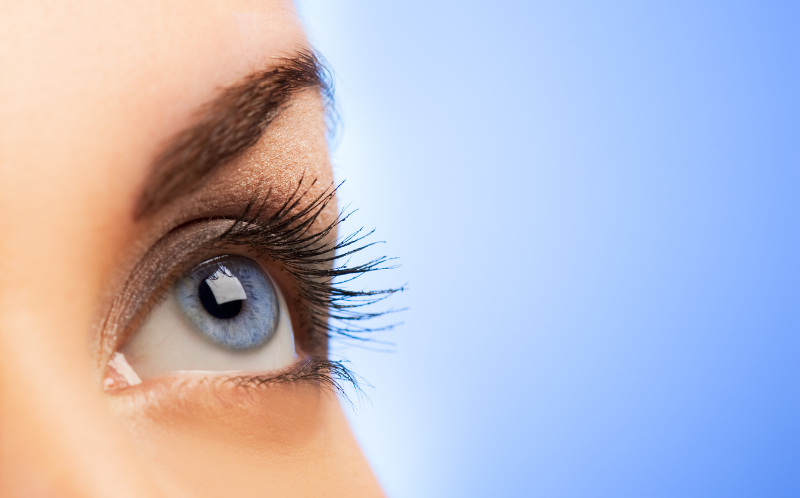LED lights have been hailed as one of the best energy-efficient inventions of the past 20 years.
They’re highly energy-efficient, producing less heat and more light, thus saving you money. In fact, LEDs use 85% electricity compared to conventional lights and 18% less energy than CFLs. (CFLs are compact fluorescent lights that use 20-30% less energy than incandescent bulbs.)
What’s not to love about LED lights then? They’re easier on your bills and they’re saving the environment?
Well, according to recent studies- plenty. According to research (and pretty extensive research too) LED lights are bad for eyes.
LED lights produce excess high-energy blue light which affects your eyes and health.
Despite this, LEDs have become super common for their cost-saving properties. When they were invented in 1962 by Nick Holonyak Jr. Back, a scientist at General Electric, LEDs became the go-to-lighting for colleges, homes and offices. Companies capitalized on the cost-saving, without knowing about their negative consequences. And being compact, LEDs became the primary source of lighting for digital devices too.
Are LED lights bad for your eyes?
To understand why LED lights are bad for your eyes, let’s first understand how LEDs are different from traditional lighting.
Incandescent bulbs:

Incandescent bulbs work by heating a small piece of wire filament to a super high temperature. (You may remember seeing a tiny piece of glowing wire in old bulbs.) This heating makes the bulb glow with light, which means that it’s powered primarily by heat rather than by producing the light itself. Incandescent bulbs die quickly because the filament soon evaporates from overheating.
CFL bulbs:

CFL bulbs are fluorescent light bulbs that have been compressed. They use mercury gas to produce light. Electric current is passed through the bulb which excites the ions in the gas. This produces short-wave and high energy UV light that causes the phosphor coating inside the lamp to glow. This is why CFLs produce intense white light, compared to other bulbs.
LED lights:

LED (Light-emitting diodes) lights work as their name suggests. There are ‘diodes’ (semiconductors) inside the light, through which electricity is passed. These semiconductors combine and produce light. This is called ‘electroluminescence’. LEDs have many advantages over the other two types of bulbs- they have a longer life, they take less space, they produce stronger light and use less energy. In fact, an incandescent lamp converts about 10% of the energy it receives into light, whereas LEDs convert nearly 100% of the energy they consume as light.
They’re also ‘directional’ lights. This means that they direct energy in one specific direction, unlike the other two types of light (incandescent and CFL) which release light in all directions. That is why the diodes in LED bulbs are positioned all around so that they release light evenly in all directions.
Despite their popularity, LED lights also have a dark side. Nick Holonyak Jr. may be turning in his grave when he hears that LEDs are not only linked to biological and sleep disturbances but also to ‘blue light hazard’. Blue light hazard is a phenomenon when your retina gets damaged if an intense light source is shined into it.
Why are LED lights bad for your eyes
Numerous studies have delved into the impact that LED lights are having on our health, without us realising it. Let’s look at some of the hazards associated with LED lights, one by one.
Retinal Damage and eye diseases
A 2020 study by The French Agency for Food, Environment and Occupational Health and Safety (ANSES) reported that LEDs can cause ‘irreversible damage’ to the retina. Our retina is the part of the eye that absorbs light from our surroundings and allows us to see.
According to their report, exposure to powerful LEDs is ‘photo-toxic and can lead to irreversible loss of retinal cells. Over time, this may lead to a loss in vision sharpness. According to their 400-page report, both ‘acute exposure’ (such as staring at a very strong light for a short while) and ‘chronic exposure’ (being exposed to low-intensity sources over a long period) both have the same effect. Chronic exposure accelerates the ageing of our retinal tissue. Over time this may cause vision loss or lead to diseases such as macular degeneration.
Sleep Disturbances
Our circadian rhythm is our body’s natural rhythm of sleeping and waking up. At night our circadian rhythm slows down our processes, produces melatonin (the sleep hormone) and makes us fall asleep. During the daytime, it signals to our brain to produce cortisol (the hormone for alertness) and start the daytime processes. You may be wondering how our circadian rhythm knows when it's day or night. A 24-hour clock is naturally built inside our bodies. However, it relies on blue light signals from the surroundings to keep it in check. That’s why when you take a flight to another country, your jetlag wears off after a while and your circadian rhythm adapts to the new time zone.
LED lights disrupt the natural circadian rhythm when our eyes receive blue light after sunset when it’s supposed to be dark.
Blue light is also linked with numerous other eye problems such as computer vision syndrome, migraines and even mental health.
The science behind why LED lights are bad for your eyes

The diagram above shows the spectral test report of the three different types of lighting, compared with sunlight.
- The LED lamp is shown by the blue line,
- CFL light is green,
- The incandescent bulb is purple,
- The solar spectrum (sunlight from the sun) is shown in yellow.
As you can see, light is composed of different types of colours. Sunlight is made of all the colours of the rainbow. Out of the seven colours, it’s only blue light (and a small amount of green light) that has health concerns. As you can see from the graph, the LED light show a huge spike of light in the blue light area, in the range of 300-455nm.
This is more than the other types of lighting- CFLs and incandescent bulbs.
When our retinas are exposed to chronic blue light, a host of problems can occur, including visual fatigue, eye diseases, sleep disturbances etc. This is because we have special receptor cells on our retina called ipRGCs (intrinsically photosensitive retinal ganglion cells) which are responsible for detecting blue light only. No such cells exist for the other colours of the light spectrum. The job of these photoreceptor cells is to tell the brain whether it’s nighttime or daytime, according to the blue light received from the sun. When it receives untimely input (such as when you LEDs on after dark), it messes with your body’s natural functioning and disrupts your circadian rhythm.
Secondly, blue light is very high in energy. In the graph above, as you move towards the warmer colours (yellow, orange and red) the wavelengths decrease and therefore the intensity of the light decreases. As you move to the cooler colours, the wavelength and energy intensity increase. When our eyes have to focus on these high-energy pixels for long periods, it can cause visual fatigue.
Lastly, LED lights have ‘invisible flicker’ due to the AC Mains power. Flicker is a fluctuation in the intensity of light and it’s of two types;
- Visible flicker (under 100 Hz)
- Invisible flicker (more than 100 Hz)
We can’t see the invisible flicker in LEDs with our naked eyes. However, if you put your smartphone in slow motion video and record an LED source, you can see for yourself the visible distortion in light. Studies have revealed that long-term exposure to flicker can lead to eye strain, headaches, blurred vision, fatigue, reduced visual task performance and even neurological problems in some scenarios.
How can I protect my eyes and health from LEDs
According to CDC (The Centre of Disease Control), you can protect your eyes through the following ways:
Going to bed early
All artificial light, whether it’s from LEDs, fluorescent bulbs or incandescent bulbs affects your normal sleep schedule. Your body’s circadian rhythm learns to adapt to the amount of light it is exposed to. If you make it a routine to stay awake late, your circadian rhythm will think it’s still daytime. Over time, your body will adapt to staying up late and make it harder for you to wake up early. This isn’t just a matter of being late to work every day- your circadian rhythm also controls processes such as feeding patterns, as well as brain activity, hormone production and cell regeneration. And if you’re receiving light at different hours of the day, your body becomes confused and its natural processes are affected. This results in mood swings and health problems.
Of course, it’s not feasible to go to bed early every day. Life happens! In this case, your best shot is using blue light-free lighting and/or blue-free glasses.
Blue light free lighting for Night-time
Blue-free lighting as the name suggests is light that has the blue wavelengths of light filtered out. This gives you all the benefits of usual lighting, while you’re saved from the detrimental effects on your retina and circadian rhythm. The lights should also use flicker-free technology.
Blue-free lighting is not the same as incandescent bulbs or CFLs! Blue light-free lights are LED lights that have the blue wavelengths of the light spectrum filtered out. This means that you get the energy-saving and long-life characteristics of LED lighting without the negative effects on your health.

When picking blue-free lighting, it’s pertinent that you pick the right product that works to mimic natural lighting conditions. The lighting you pick should
All of BlockBlueLight’s bulbs and lamps have been are verified to be free of blue light (you can check the spectral test reports for each product). They also use flicker-free technology and are low EMF.
There are 2 types of blue light free lighting:
Evening bulbs (blue light free)
Evening bulbs should block 100% of blue light to be effective, since we’re naturally not supposed to be exposed to blue light after sunset. Our SweetDreams Bulb blocks 100% of blue light across the full spectrum (300-455 nm). It’s a general-purpose bulb that can be used to replace your regular LEDs at home. The spectral test report is also available on the product page for verifying its effectiveness.
Night-time bulbs (blue and green light free)
These red bulbs can be used as night lights or while you are in bed. The best thing about these is that they give you just enough light to read, without affecting your sleepiness, so you can nod off with these on!
For nighttime bulbs to be effective, they must target green light, as well as blue light. Research has shown that green light also disrupts melatonin production. Our Twilight Bulb blocks 100% of blue and green light from 400-550 nm. Any less than this range and you won’t be benefitting from the full effects of blue-free lighting.
Full Spectrum lighting for Daytime
During the daytime getting full spectrum light is key to regulating mood and maintaining stable energy.
Standard LED lights are not full spectrum light, they contain extremely high level of blue light and are very void of the rest of the colour spectrum of yellow, orange, and red light, this also contributes to why LEDs are so bad for your eyes. Full spectrum light has balanced levels of blue light along with all the other colours making is the same as outdoor natural light, this type of light is much more biological friends and better for your eyes.

Tired of constantly switching lights on and off? If you want maximum efficiency, the BioLight Bulb is for you. This is the first-of-its-kind full spectrum light! It switches between three modes and colours:
- Day Mode: Full-spectrum white light that replicates the sun’s light and is flicker-free
- Mixed Mode: Warm light that is low in the blue spectrum, to be used in the evenings
- Night Mode: Amber light that blocks 100% of blue light to prepare your body for bed
These 3 modes mimic the light patterns of the sun.
As with all our products, it’s verified to be zero-flicker and low EMF.
If you have any more questions on blue-free lighting, feel free to browse our FAQs or get in touch. We would love to hear from you!
References:
Cosic, I., Cosic, D., & Lazar, K. (2016). Environmental Light and Its Relationship with Electromagnetic Resonances of Biomolecular Interactions, as Predicted by the Resonant Recognition Model. International Journal Of Environmental Research And Public Health, 13(7), 647. doi: 10.3390/ijerph13070647
Module 6. Improving Your Sleep and Alertness, Improve Sleep by Avoiding Light | NIOSH | CDC. (2022). Retrieved 7 March 2022, from https://www.cdc.gov/niosh/work-hour-training-for-nurses/longhours/mod6/07.html#:~:text=You%20can%20prevent%20blue%20light,with%20special%20lenses%20for%20this.&text=Other%20devices%20may%20become%20available,type%20of%20sunglasses%20to%20use
(2022). Retrieved 7 March 2022, from https://www.anses.fr/en/content/leds-blue-light





